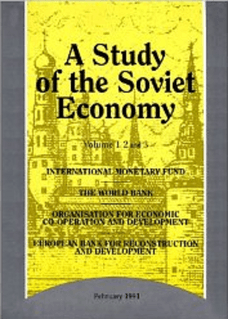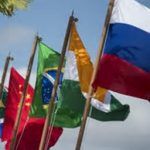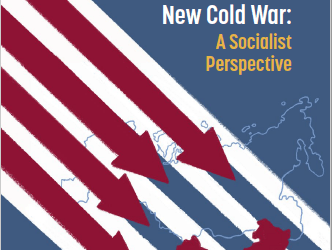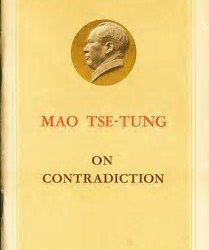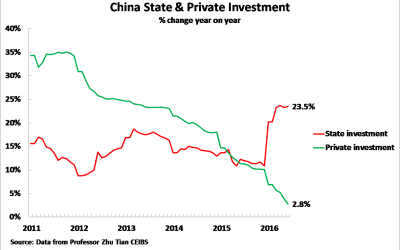This article, published in October 1991, accurately predicted that ‘shock therapy’ recommended for Russia by Western economic institutions, and supported by 95% of Western economists, would lead to economic catastrophe in Russia – pushing its economy backwards towards becoming a raw material producing appendage of the West. Determination that China should avoid any such economic catastrophe was one of my main motives for studying and being in China. Fortunately China took an absolute opposite course – showing the superiority of its economic thinking to the West. But the consequences of Russia following the advice of the IMF and other economic institutions led to the greatest economic collapse in a major economy in peacetime since the Industrial Revolution.
Russia’s economy contracted by almost 40%, male life expectancy dropped by six years to only 58 by 1998, and in 2013 Russia’s population was still 4.6 million less than in 1991. Russia’s GDP growth over the period from 1991, the last year of the USSR, to 2013 was 1.0% a year – compared to 10.2% in China. In Ukraine, the second largest state of the former USSR, the result was worse. In 2013, Ukraine’s GDP was still 23% below its level in 1991 – i.e. Ukraine experienced net negative growth over a 22 year period. Major wars took place in Chechnya, between Armenia and Azerbaijan, in Georgia, in the Ukraine and a serious problem of terrorism continues to the present.
Few greater tests of the superiority of China’s economic thinking to the West can have been imagined.
Russia’s economy contracted by almost 40%, male life expectancy dropped by six years to only 58 by 1998, and in 2013 Russia’s population was still 4.6 million less than in 1991. Russia’s GDP growth over the period from 1991, the last year of the USSR, to 2013 was 1.0% a year – compared to 10.2% in China. In Ukraine, the second largest state of the former USSR, the result was worse. In 2013, Ukraine’s GDP was still 23% below its level in 1991 – i.e. Ukraine experienced net negative growth over a 22 year period. Major wars took place in Chechnya, between Armenia and Azerbaijan, in Georgia, in the Ukraine and a serious problem of terrorism continues to the present.
Few greater tests of the superiority of China’s economic thinking to the West can have been imagined.
* * *
In 1991 for the first time the three major international economic institutions – the IMF, World Bank ,and OECD – published a joint study of a single country. The subject was the USSR
The three volume result is a masterpiece of factual economic analysis. It also spells out in detail a major section of the West’s proposals for restoring capitalism in the former USSR. It is one of the most chilling documents imaginable.
The core section is the ‘Assessment of Medium Term Economic Prospects’. Its essential proposal is summed up by the fact that it only deals in detail with two sectors of the Soviet economy – energy and agriculture. Indeed the entire report positively drools over Soviet energy and agriculture potential.
It notes: ‘The USSR has the largest natural gas reserves in the world… Total proven recoverable coal reserves… [include] 140 billion metric tons of hard coal… and 100 billions metric tons of lignite, which could theoretically support a steady growth in coal production for many decades… The USSR is understood to contain the world’s largest uranium reserves, the world’s largest stockpile of uranium, and one of the largest uranium production capacities.
Almost as much enthusiasm is displayed for Soviet agricultural potential. ‘The area cultivated… covers about 230 million hectares, giving the USSR the most extensive land wealth of any country in the world.’
In contrast to such ‘medium term’ recommendations for energy and agriculture none are given for Soviet manufacturing. Instead the study claims that despite a level of manufacturing trade which is ‘extraordinary low’, and therefore an obvious case for expansion: ‘It is virtually impossible to judge…underlying comparative advantages the Soviet economy might enjoy in the industrial sector’. Therefore: ‘it may be more effective to concentrate on increasing exports of energy and raw materials’.
Furthermore it is anticipated that with the reintroduction of a capitalist economy industrial production will collapse. In the case of the report’s computer simulation: ‘Output… drops sharply following price liberalisation… industrial output is projected to drop 20 per cent in the first year of the radical scenario, with total output (GDP) declining something like 10 per cent.’
With energy and agriculture exports soaring, and industry collapsing, what is proposed is that Soviet Union undergo massive deindustrialisation to become a supplier of energy and agriculture to the capitalist market.
This goal is, naturally, not explicitly spelt out – it might lead to explosive resistance. But it is clear in the figures.
In addition to its immediate impact this transformation would condemn th USSR to permanent poverty. No long term economic trend is more firmly established than that for the price of manufactured goods to rise relative to raw materials and agriculture – which is why so many third world countries today are trapped in a vicious cycle of poverty. The fall of raw materials prices would be even greater if the former USSR came on stream as a huge source of low cost supply. The Soviet Union, after such an economic transformation, would not simply be deindustrialised but condemned to permanent poverty and underdevelopment.
This proposed change in the structural basis of the Soviet economy makes the IMF’s plans for the USSR much worse even than those for the rest of Eastern Europe.
IMF ‘stabilisation’ proposals both for Eastern Europe and Latin America and Africa always assert that after the initial economic collapse there will be economic recovery. Experience of such plans shows that while the initial collapse is invariably underestimated the recovery does not take place.
Thus western agencies are already admitting that they painted a rosy view of what would occur with the reintroduction of capitalism into Eastern Europe. This May’s World Bank report The Transformation of Economies in Eastern and Central Europe admitted for the first time that as a result of the stabilisation programmes started after 1989 Poland, Hungary, and Czechoslovakia will not regain their previous income levels until 1996. Bulgaria, Romania, and Yugoslavia will not regain them until the next century.
But at least the IMF proposed that the main East European countries remained manufacturing/service based economies. The ex-USSR’s position as a supplier of raw materials would be far worse.
This can be seen clearly in the report’s projections for Soviet living standards. While IMF proposals always understate the decline in living standards that will result from their plans – the Polish stabilisation programme, for example, reduced real wages by 30 per cent in six months – the report does indicate the scale of attack on the Soviet peoples that would result.
The Report calls for, first, drastic reduction in subsidies for the price of consumer goods – arguing for: ‘real [government] expenditure cuts of 5 per cent of GDP.’ It notes: ‘Even with large cuts in military spending and state investment, this could not be achieved without significant reductions in subsidies on consumer goods. Indeed, the costs of increased social transfers to assist the unemployed and other suffering economic, hardship seem feasible only if general consumer subsidies are eliminated. Even then, costs would need to be carefully controlled – for example by a stringent means test’.
This is not a call for a move to a rational pricing system – which the USSR desperately needs. A move to a system where protection of the low paid is ensures in the form of benefits, and not price distortions, is indispensable in the former Soviet Union. But a simple price reform would require that funds presently going into subsidies instead go into benefits and wages – to compensate for the prices rises.
This is not what the report advocates. Under the guise of a ‘price reform’ it actually proposes a reduction in consumer expenditure of 5 per cent of GDP. As consumer expenditure is 40 per cent of the Soviet GDP this is a cut in consumption of over 12 per cent.
The mechanism for the reduction in living standards is clear. A price rise of 60 per cent is projected. Simultaneously incomes policy should be introduced to ensure that wages will not rise in line with prices.
The report is explicit that ‘full compensation is not feasible’ for price rises. Instead: ‘there is a need to set a ceiling for wage increases.’
The report projects that unemployment: ‘rises rapidly, from an estimated 2 per cent in 1990 to over 10 per cent in 1992’. To make this possible the stationary right to a job must be abolished: ‘In the past, the key instrument in the USSR for providing social protection was a formal job guarantee written into the constitution… such a guarantee is not possible in a market economy… Not surprisingly, recent reform proposals leading towards a market economy have including eliminating the employment guarantee.’
In other words in two years industrial output would fall by a fifth, consumer expenditure by an eighth, and unemployment would rise to over 10 per cent. The report admits, and this is a considerable understatement in the light of what has taken place in the rest of Eastern Europe: ‘There are two major risks… One is that inflation could prove much stronger and slower to recede than suggested in the scenario. The second is that the collapse of output could be much larger.’
Turning to those likely to benefit from such a programme of recreating capitalism the report foresees considerable problems in ‘public relations’ in the light of an apparently very accurate assessment by the Soviet population of what is taking place: ‘It is widely believed in the USSR that many of those acquiring economic power in the enterprises, and in the process taking ownership of state assets, are members of the nomenklatura, who are exploiting their rank and insider information. An other line of popular belief is that many of the new entrepreneurs are essentially criminals,
emerging from the underworld of black marketeers and speculators. This negative public image could generate a serious backlash and impede the transition to free markets.’
Therefore, the report concludes: ‘The major question mark about a radical programme [of reintroduction of capitalism] is whether it is possible to achieve sufficient political consensus to implement it.’
The political implications of such an economic programme are clear. No democratic government could push through the scale of reduction of living standards. Currently favoured models for Eastern Europe and the Soviet Union among Western analysts are therefore Chile and the South Korean military dictatorship. The scale of political conflict that would result would tear the USSR apart along national lines.
The perspectives of the IMF is therefore deindustrialisation of the USSR, its transformation into a supplier of raw materials for Western economies, the installation of a dictatorial regime, and dismemberment of the state along national lines.
There is one previous author who proposed, and attempted to implement, such a programme for the USSR. His name was Adolf Hitler. The IMF/World Bank/OECD study would be more appropriately termed a sanitised economic version of Mein Kampf.
There are no ravings about sub-human races, depopulation, or Lebensraum. There is smooth economists language about ‘comparative advantage’. The programme proposes that the changes should be made by IMF structural adjustment programmes and not with an army – which is a difference. But the similarity of economic programme is striking.
Indeed a surprisingly large part of what is taking place in Eastern Europe today is the ‘cold’ application of the programme openly mapped out by Hitler – and which represents the historical goals of German capitalism. This includes the creation of a separate Croat state and dismemberment of the USSR into the Ukraine, Belorussia, Russia etc. A capitalist leopard may change how it hunts but it doesn’t change its spots.
At $75 this is not a report many readers will buy. But it repays the effort to borrow it. No other publications so demystifies the rhetoric on ‘freedom’ for Eastern Europe.
A Study of the Soviet Economy, OECD Paris, $75.
* * *
This article originally appeared in Campaign Group News on 1 October 1991
The three volume result is a masterpiece of factual economic analysis. It also spells out in detail a major section of the West’s proposals for restoring capitalism in the former USSR. It is one of the most chilling documents imaginable.
The core section is the ‘Assessment of Medium Term Economic Prospects’. Its essential proposal is summed up by the fact that it only deals in detail with two sectors of the Soviet economy – energy and agriculture. Indeed the entire report positively drools over Soviet energy and agriculture potential.
It notes: ‘The USSR has the largest natural gas reserves in the world… Total proven recoverable coal reserves… [include] 140 billion metric tons of hard coal… and 100 billions metric tons of lignite, which could theoretically support a steady growth in coal production for many decades… The USSR is understood to contain the world’s largest uranium reserves, the world’s largest stockpile of uranium, and one of the largest uranium production capacities.
Almost as much enthusiasm is displayed for Soviet agricultural potential. ‘The area cultivated… covers about 230 million hectares, giving the USSR the most extensive land wealth of any country in the world.’
In contrast to such ‘medium term’ recommendations for energy and agriculture none are given for Soviet manufacturing. Instead the study claims that despite a level of manufacturing trade which is ‘extraordinary low’, and therefore an obvious case for expansion: ‘It is virtually impossible to judge…underlying comparative advantages the Soviet economy might enjoy in the industrial sector’. Therefore: ‘it may be more effective to concentrate on increasing exports of energy and raw materials’.
Furthermore it is anticipated that with the reintroduction of a capitalist economy industrial production will collapse. In the case of the report’s computer simulation: ‘Output… drops sharply following price liberalisation… industrial output is projected to drop 20 per cent in the first year of the radical scenario, with total output (GDP) declining something like 10 per cent.’
With energy and agriculture exports soaring, and industry collapsing, what is proposed is that Soviet Union undergo massive deindustrialisation to become a supplier of energy and agriculture to the capitalist market.
This goal is, naturally, not explicitly spelt out – it might lead to explosive resistance. But it is clear in the figures.
In addition to its immediate impact this transformation would condemn th USSR to permanent poverty. No long term economic trend is more firmly established than that for the price of manufactured goods to rise relative to raw materials and agriculture – which is why so many third world countries today are trapped in a vicious cycle of poverty. The fall of raw materials prices would be even greater if the former USSR came on stream as a huge source of low cost supply. The Soviet Union, after such an economic transformation, would not simply be deindustrialised but condemned to permanent poverty and underdevelopment.
This proposed change in the structural basis of the Soviet economy makes the IMF’s plans for the USSR much worse even than those for the rest of Eastern Europe.
IMF ‘stabilisation’ proposals both for Eastern Europe and Latin America and Africa always assert that after the initial economic collapse there will be economic recovery. Experience of such plans shows that while the initial collapse is invariably underestimated the recovery does not take place.
Thus western agencies are already admitting that they painted a rosy view of what would occur with the reintroduction of capitalism into Eastern Europe. This May’s World Bank report The Transformation of Economies in Eastern and Central Europe admitted for the first time that as a result of the stabilisation programmes started after 1989 Poland, Hungary, and Czechoslovakia will not regain their previous income levels until 1996. Bulgaria, Romania, and Yugoslavia will not regain them until the next century.
But at least the IMF proposed that the main East European countries remained manufacturing/service based economies. The ex-USSR’s position as a supplier of raw materials would be far worse.
This can be seen clearly in the report’s projections for Soviet living standards. While IMF proposals always understate the decline in living standards that will result from their plans – the Polish stabilisation programme, for example, reduced real wages by 30 per cent in six months – the report does indicate the scale of attack on the Soviet peoples that would result.
The Report calls for, first, drastic reduction in subsidies for the price of consumer goods – arguing for: ‘real [government] expenditure cuts of 5 per cent of GDP.’ It notes: ‘Even with large cuts in military spending and state investment, this could not be achieved without significant reductions in subsidies on consumer goods. Indeed, the costs of increased social transfers to assist the unemployed and other suffering economic, hardship seem feasible only if general consumer subsidies are eliminated. Even then, costs would need to be carefully controlled – for example by a stringent means test’.
This is not a call for a move to a rational pricing system – which the USSR desperately needs. A move to a system where protection of the low paid is ensures in the form of benefits, and not price distortions, is indispensable in the former Soviet Union. But a simple price reform would require that funds presently going into subsidies instead go into benefits and wages – to compensate for the prices rises.
This is not what the report advocates. Under the guise of a ‘price reform’ it actually proposes a reduction in consumer expenditure of 5 per cent of GDP. As consumer expenditure is 40 per cent of the Soviet GDP this is a cut in consumption of over 12 per cent.
The mechanism for the reduction in living standards is clear. A price rise of 60 per cent is projected. Simultaneously incomes policy should be introduced to ensure that wages will not rise in line with prices.
The report is explicit that ‘full compensation is not feasible’ for price rises. Instead: ‘there is a need to set a ceiling for wage increases.’
The report projects that unemployment: ‘rises rapidly, from an estimated 2 per cent in 1990 to over 10 per cent in 1992’. To make this possible the stationary right to a job must be abolished: ‘In the past, the key instrument in the USSR for providing social protection was a formal job guarantee written into the constitution… such a guarantee is not possible in a market economy… Not surprisingly, recent reform proposals leading towards a market economy have including eliminating the employment guarantee.’
In other words in two years industrial output would fall by a fifth, consumer expenditure by an eighth, and unemployment would rise to over 10 per cent. The report admits, and this is a considerable understatement in the light of what has taken place in the rest of Eastern Europe: ‘There are two major risks… One is that inflation could prove much stronger and slower to recede than suggested in the scenario. The second is that the collapse of output could be much larger.’
Turning to those likely to benefit from such a programme of recreating capitalism the report foresees considerable problems in ‘public relations’ in the light of an apparently very accurate assessment by the Soviet population of what is taking place: ‘It is widely believed in the USSR that many of those acquiring economic power in the enterprises, and in the process taking ownership of state assets, are members of the nomenklatura, who are exploiting their rank and insider information. An other line of popular belief is that many of the new entrepreneurs are essentially criminals,
emerging from the underworld of black marketeers and speculators. This negative public image could generate a serious backlash and impede the transition to free markets.’
Therefore, the report concludes: ‘The major question mark about a radical programme [of reintroduction of capitalism] is whether it is possible to achieve sufficient political consensus to implement it.’
The political implications of such an economic programme are clear. No democratic government could push through the scale of reduction of living standards. Currently favoured models for Eastern Europe and the Soviet Union among Western analysts are therefore Chile and the South Korean military dictatorship. The scale of political conflict that would result would tear the USSR apart along national lines.
The perspectives of the IMF is therefore deindustrialisation of the USSR, its transformation into a supplier of raw materials for Western economies, the installation of a dictatorial regime, and dismemberment of the state along national lines.
There is one previous author who proposed, and attempted to implement, such a programme for the USSR. His name was Adolf Hitler. The IMF/World Bank/OECD study would be more appropriately termed a sanitised economic version of Mein Kampf.
There are no ravings about sub-human races, depopulation, or Lebensraum. There is smooth economists language about ‘comparative advantage’. The programme proposes that the changes should be made by IMF structural adjustment programmes and not with an army – which is a difference. But the similarity of economic programme is striking.
Indeed a surprisingly large part of what is taking place in Eastern Europe today is the ‘cold’ application of the programme openly mapped out by Hitler – and which represents the historical goals of German capitalism. This includes the creation of a separate Croat state and dismemberment of the USSR into the Ukraine, Belorussia, Russia etc. A capitalist leopard may change how it hunts but it doesn’t change its spots.
At $75 this is not a report many readers will buy. But it repays the effort to borrow it. No other publications so demystifies the rhetoric on ‘freedom’ for Eastern Europe.
A Study of the Soviet Economy, OECD Paris, $75.
* * *
This article originally appeared in Campaign Group News on 1 October 1991
Related articles
BRICS are more important for world growth than the G7
The annual BRICS summit, hosted by China in Xiamen on 3-5 September, is the second of two major ...
Read More Quelles sont les forces qui poussent les USA à une agression militaire internationale croissante?
John Ross (https://mronline.org/author/johnross/ ) 24 avril 2022 Cet article de John Ross (Luo Siyi) est la traduction sous ...
Read More Why do Western economies have hard landings but China doesn’t?
IntroductionThe media outside China periodically carries predictions of a China ‘hard landing’. For example George Soros grabbed headlines ...
Read More Communist Party of China studying Mao Zedong’s essays ‘On Contradiction’ and ‘On Practice’ ahead of Party Congress
One of the more inaccurate ideas in the 'Western' media is that China is a capitalist country in ...
Read More Why are China and India growing so fast?
The world’s two most rapidly growing major economies are China and India. Both China and India show a ...
Read More 

